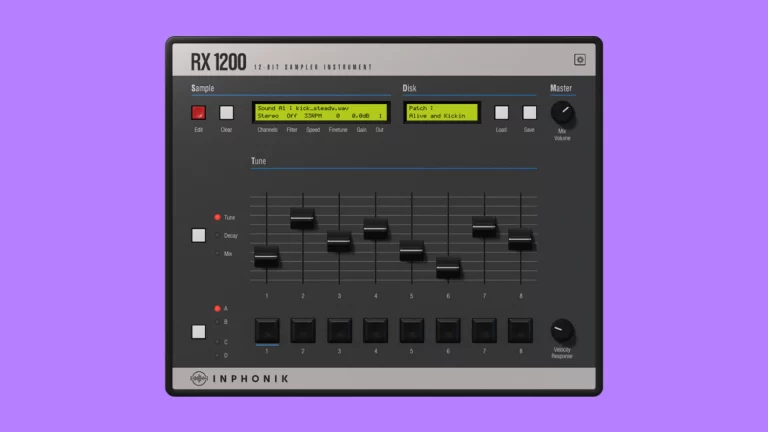Inphonik take on the Legendary E-mu SP1200 with the RX1200.
When it comes to iconic pieces of sampling hardware they don’t get much mightier than the E-mu SP1200. This 80’s 12-bit beast has reached legendary status in recent years, particularity within the Boom-Bap Hip-Hop fraternity. And with SP1200’s becoming increasingly sought after, if you’re lucky enough to find one now, the chances are you won’t be left with much change out of £4000!

So imagine the anticipation as Inphonik reveal a software version for under £40! That’s a staggering One Hundred times cheaper than an OG machine. BUT will it pack the punch of the original? Let’s find out.
A brief SP History lesson
Launched by E-mu Systems in 1987 the SP1200 was the predecessor to the SP12. The SP-12 (which stands for Sampling Percussion at 12 bits) was released just a year before the 1200. The SP-12 is widely credited as being the first drum machine to offer a sampling facility. This revolutionary feature meant you were no longer dependent on the stock internal preset drums. You now had the means to create and program your own totally original drum and percussive sounds.
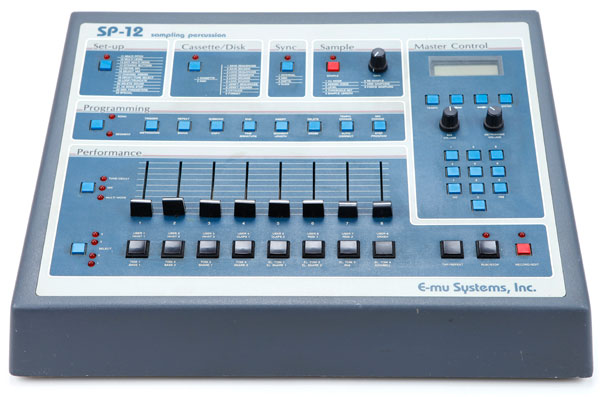
One of the main differences between the SP-12 and the SP1200 was in terms of saving. The SP-12 stored its drum sounds and samples in ROM. You could save sounds but this had to be done on an unreliable and clunky external 5 1⁄4-inch floppy disc drive. The 1200 featured RAM and as such came with a built-in 31⁄2” drive. The total sample time was also doubled to an eye-watering ten whole glorious 12-bit seconds.
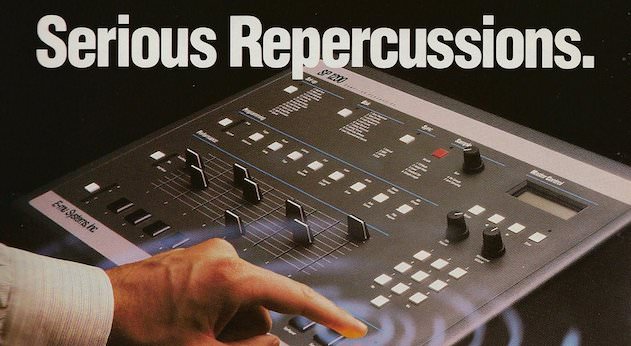
The SP1200 enjoyed a monopoly in the sampling drum machine market for just over a year. Then in 1988 Akai released it’s answer to the SP1200, the Roger Linn designed MPC 60. And the rest as they say is history.
The Making of a Legend
As with so many pieces of classic music hardware, The TR808 being a prime example, E-mu designed the SP-12/1200 with a singular purpose in mind. But once out in the world producers had other ideas. And in the case of the SP1200 these ideas would go on to influence the course of musical history.
By 1986 a select few Hip Hop producers, most notably Marly Marl, were starting to sample the old Break Beat records from which the culture was born. Up until then, Hip Hop was being made on drum machines like the Tr 808 and Oberhiem DMX. Producers in the know worked out that they could now sample the drum hits from these classic breaks using the SP-12/1200 and then create their own funky breakbeat derivatives.
By the early 90s this practice was commonplace and full tracks including musical loops were being made solely on the SP1200. In order to overcome the limited 10-second sample time records were sampled in on 45rpm and then slowed down. This created the classic anti-aliasing effect that became so synonymous with the SP sound. Many subscribe to the notion that the limitations of 10 seconds of sample time forces you to be even more creative with your sample choices.

And over 30 years later producers still crave that iconic SP1200 sound and simple stripped-back workflow. With Boom Bap Hip-Hop and the classic 90s sound as popular as ever, producers are desperate to relive this era by using THE defining tool. And with the emergence of Lofi a whole new generation is being lured in by the SP1200’s unique charm.
SP vs RX Sound Clash!!!
So, with demand vastly outstripping supply, and the SP1200 gaining grail-like status, it seems as though Inphonik are perfectly poised for success. But it’s all very well designing an alluring SP1200 modelled GUI. The thing has got to sound like an original! Well, as a Hip-Hop producer that spent most of the 90s sat in front of a slightly temperamental SP1200 I’m in a pretty good position to judge. And after a few hours with the RX1200 my verdict is in…. Inphonik can take a bow!
Although I no longer use an SP1200 I’m all too familiar with its distinctive sound. Inphonic have successfully captured the anti-aliasing effect as well as the subtle digital crunch. I use the word subtle as many of the bit-crunching plugins that profess to emulate the SP1200 often tend to be a bit OTT. Yes, you can hear a degree of digital colouration with an SP but it certainly doesn’t overpower the samples.
The area where the SP always shone for me was in the low and low mid frequencies. The SP’s ability to create solid punchy kicks with serious weight while remaining balanced was in my experience unrivalled. The SP managed to produce an equivilent low end feeling to to those classic 60’s and 70’s Jamacian reggae recordings!
I’m pleased to report that the RX1200 doesn’t disappoint in this department. I’m not sure if it’s quite as weighty as an original but without one available I couldn’t do a direct comparison. It does however affect the sound of the kicks in a way that up until now I have been unable to successfully replicate using DAW processing.
I may not have an original SP to directly compare to the RX1200 but fear not. Inphonik are so confident in the sound of the RX1200 that they’ve produced their own A/B test video. Check it out below and decide for yourself.
RX 1200 features
One of the main decisions that was made in the development of the RX1200 was to not include the SP’s sequencer. A decision that I think is totally justified as this makes its DAW integration seamless. And also, unlike MPC’s with their innovative swing functionality, the SP’s sequencer, although very tight did not have such a distinctive feel.
Of course, there are areas where the RX1200 outperforms the original. Most noticeably sample time and editing. You’re no longer restricted to a total of 10 seconds sample time with 2.5secs max per individual sample. I’m not sure if purists will argue that this should have been kept in as a test for modern beatmakers. (Inphonik could maybe introduce this limitation in a future update just for a bit of fun)
Sample editing is also made a lot more accurate with a zoomtastic waveform display capable of fine start/end/loop point editing. This is certainly an improvement over the originals rather course slider-operated controls.
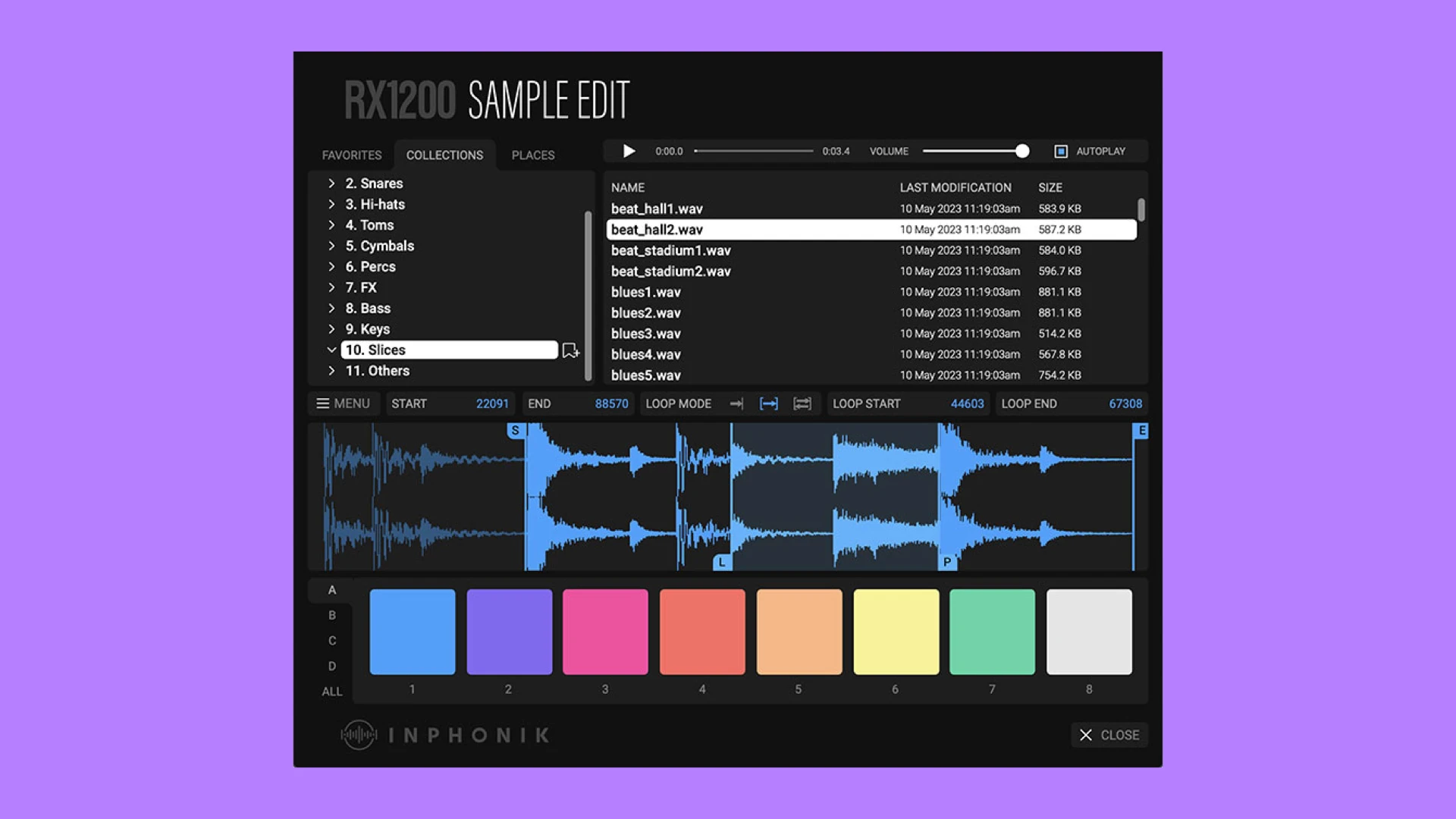
Much of the simplistic drum-orientated editing features of the original remain intact including the envelope decay and velocities. There is also a pitch option that can be selected via chromatic mode. This faithfully replicates the original where you could pitch a sample over the 8 pads. It would have been nice to see Inphonik support a wider chromatic range than its 16 notes. Thats still double that of the original though.
All in all I think Inphonik have made the right calls when it comes to the RX1200’s functionality. They have created a tool that provides all the benifits of an SP i.e sound and simplicity while being easy to integrate into a modern DAW environment.
12-Bit alternatives
If you’re trying to accuratly capture the 12-bit sound and feel of an SP there are a few alternative options out there. Firstly for those with deep pockets Dave Rossum who originally designed the SP has just created a reissued model. At $3,999 its not far off the price of a used original so way out of most peoples price range.
If you really want to keep to the original Hardware ethos, the Isla S2400 could be a good option. In terms of sound it offers both 16 and 12-bit sample engines, the later sounding very close to an SP1200.

Software wise there is the ESPi by Low-Hiss.com. Like the RX1200 its a software emulation of an SP1200. I havent personally tried the ESPi but the examples I have heard online sound pretty authentic. I have however spoken to a number of people who have tried it and they have all mentioned it’s a tad clunky to use. But at just over $30 it could also be worth checking out as an alternative to the RX1200.
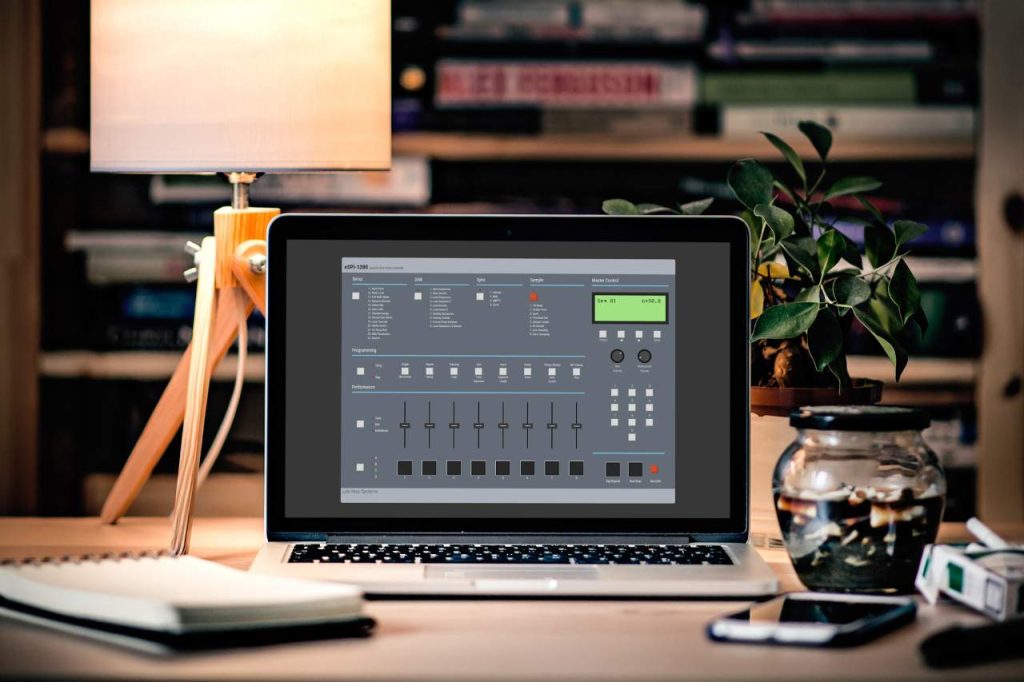
And finally as mentioned you could try using Bit Crushers to try to emulate that 12-Bit magic. SampleX by BeatSkillz.com and Decimort 2 by the D 16 group both have dedicated SP1200 settings. As previously mentioned I do find these settings to be slightly over the top. They add a little too much distortion and charactor for my ears.
Conclusion
Reading the many comments on the Inphonik demo videos people are clearly delighted that they choose to take on the mighty SP1200. The general consensus is they totally aced it. There are a number of suggestions in the comments for further improvement. Hopefully Inphonik will take these on board and continue to perfect what is already a pretty awsome Instrument plug-in.
At such an attractive price point Inphonik are sure to do well with this one. So, unless you’re craving the status an original unit comands or just really need to be restricted by 10 seconds of sample time, there’s no longer any vustifiable reason to spend a small fortune on an original SP.
Remember – RouteNote Create subscriptions start from as little as $2.99. You also get 10 FREE credits to spend on samples along with access to our FREE sample pack bundle when you sign-up!
